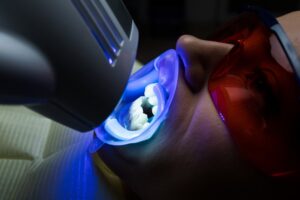
A bright, white smile is often associated with health, confidence, and beauty. With the abundance of over-the-counter whitening products and the convenience of at-home kits, more people than ever are whitening their teeth. But when done too often, teeth whitening can lead to more harm than good. Over-whitening not only diminishes the health of your teeth and gums but can also create long-term damage that’s difficult to reverse.
Here’s what you need to know about the dangers of whitening your teeth too frequently and how to whiten safely.
Enamel Erosion
Your tooth enamel is the hardest substance in your body, but it isn’t invincible. Most whitening products use hydrogen peroxide or carbamide peroxide to bleach the enamel. While safe in moderation, frequent exposure to these chemicals can weaken and erode the enamel over time. Once enamel is worn away, it doesn’t grow back, and your teeth become more vulnerable to cavities, decay, and sensitivity.
Increased Tooth Sensitivity
One of the most common side effects of teeth whitening is tooth sensitivity, especially to hot, cold, or sweet foods. When enamel thins or tiny tubules within the teeth are exposed during whitening, the inner nerve endings can become more sensitive. Whitening too frequently only compounds this issue, making it painful to eat or drink certain things. For some, this sensitivity can become chronic.
Gum Irritation and Tissue Damage
Whitening agents aren’t just tough on enamel – they can also irritate your gums. If the bleaching gel or strips come into contact with your soft tissues too often, they can cause redness, inflammation, peeling, or even chemical burns. Repeated overexposure increases your risk of damaging the delicate tissues around your teeth, leading to discomfort and possible long-term gum recession.
Uneven or Artificial-Looking Results
When teeth are over-whitened, they can begin to appear chalky, translucent, or unnaturally white. In some cases, they may not even match your skin tone, lips, or existing dental work like crowns or fillings, which do not respond to whitening agents. This can create a mismatched or unnatural appearance, defeating the goal of a healthy-looking smile.
Masking Underlying Dental Problems
Excessive whitening might temporarily improve your smile’s appearance, but it can also hide more serious issues like decay, infection, or enamel erosion. If you’re whitening without the supervision of a dental professional, you may miss the signs of problems that need treatment. Whitening should never be a substitute for proper dental care.
How to Whiten Safely
Here are some ways to safely whiten your teeth without worrying about overdoing it:
- Consult your dentist before beginning any whitening routine.
- Limit whitening treatments to every 6 to 12 months unless otherwise advised.
- Use products that carry the ADA Seal of Acceptance.
- Avoid at-home remedies like lemon juice or baking soda, which can damage enamel.
- Opt for touch-ups instead of full treatments to maintain brightness without overexposure.
Whitening your teeth can boost your confidence but only when done safely and in moderation. Overdoing it can lead to sensitivity, damage, and long-term oral health problems. If you’re unsure how often to whiten or whether your current routine is safe, talk to your dentist. A healthy smile is just as important as a white one.
About the Author
Dr. Stan Drabik has been practicing for more than 20 years. He is a graduate of SUNY at Buffalo School of Dental Medicine and completed his orthodontic certificate at Boston University’s Henry M. Goldman School of Dental Medicine. Today, Dr. Drabik is a member of the American Association of Orthodontists and the American Dental Association. If you’re looking for a guided, professional teeth whitening experience, turn to Dr. Drabik and our team to help you achieve dramatic results quickly. Visit our website to schedule your appointment or call one of our conveniently located offices in the Webster and Rochester areas.

